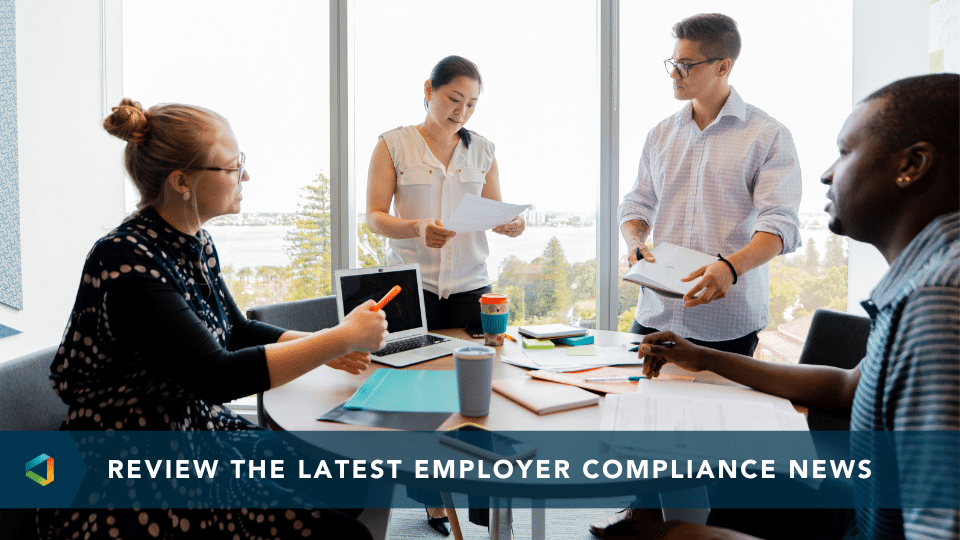Compliance Confidence
Hold Your Handbooks: There is a New NLRB Standard for Finding Employer Policies Unlawful
Hold Your Handbooks: There is a New NLRB Standard for Finding Employer Policies Unlawful
In Stericycle, Inc. and Teamsters Local 628, the National Labor Relations Board (NLRB) created a new standard for determining whether an employer’s work rule or policy that does not expressly restrict employees’ protected concerted activity is facially unlawful under the National Labor Relations Act (NLRA).
Applies to:
All Employers Subject to the NLRA
Effective:
August 2, 2023
Key points about this newly-created standard are summarized as follows:
-
• The NLRB adopted a new version of the Lutheran Heritage rule for determining when employer policies are unlawful under the NLRA.
• The rule focuses on whether an employee could reasonably interpret the employer’s policy to have a coercive meaning in violation of their Section 7 rights. The employer’s intent behind the rule is irrelevant.
-
• An employer can rebut the presumption that the policy is unlawful if it can show that the policy “advances a legitimate and substantial business interest and that the employer is unable to advance that interest with a more narrowly tailored rule.”
Overview of Recent Developments
In recent years, the NLRB standard was defined by the tiered analysis originally put forth in Boeing Co. (and modified by LA Specialty Produce), which itself had replaced the analysis in Lutheran Heritage Village-Livonia.
In Stericycle, Inc. and Teamsters Local 628, the NLRB said the “problem with the standard from Boeing and LA Specialty Produce is that it permits employers to adopt overbroad work rules that chill employees’ exercise of their rights under Section 7.” Their line of reasoning was that the current standard fails to account for the economic dependency of employees on their employers. Boeing gives too little weight to the burden a work rule could impose on employees’ Section 7 rights. At the same time, Boeing’s balancing test gives too much weight to employer interests. Boeing also “condones overbroad work rules by not requiring the party drafting the work rules—the employer—to narrowly tailor its rules to only promote its legitimate and substantial business interests while avoiding burdening employee rights.” Ultimately, the Board rejected and overruled Boeing’s tiered analysis (and the cases relying on it), “returning to a particularized analysis of specific rules, their language, and the employer interests actually invoked to justify them.”
The primary criticism of the new Stericycle standard is that it creates significant uncertainty for employer policies whose legality turns on whether an employee could reasonably interpret the policy to have a coercive meaning.
In Stericycle, the NLRB created a new standard that builds on and revises the Lutheran Heritage standard. Specifically, Lutheran Heritage recognized that overbroad workplace rules and policies may chill employees in the exercise of their Section 7 rights and focused on the employees’ NLRA-protected rights. The NLRB reasoned that although Lutheran Heritage implicitly allowed the Board to evaluate employer interests when considering whether a particular rule was unlawfully overbroad, the standard itself did not clearly address how employer interests factored into the Board’s analysis.
So, What Does the New Rule Say?
The new standard maintains that the NLRB’s General Counsel must prove that a challenged employer rule has a reasonable tendency to chill employees from exercising their Section 7 rights. However, the Board clarified that it will “interpret the [employer’s] rule from the perspective of an employee who is subject to the rule and economically dependent on the employer, and who also contemplates engaging in protected concerted activity.” The employer’s intent in maintaining a rule is “immaterial.” Rather, if an employee could reasonably interpret the employer’s rule to have a coercive meaning, the General Counsel will have met the required burden, “even if a contrary, noncoercive interpretation of the rule is also reasonable.” As a result, the rule would be presumptively unlawful. However, the employer may rebut that presumption by proving that the rule “advances a legitimate and substantial business interest and that the employer is unable to advance that interest with a more narrowly tailored rule.” If the employer proves its defense, then the work rule would be found lawful.
What Does This Mean for Employers?
The primary criticism of the new Stericycle standard is that it creates significant uncertainty for employer policies whose legality turns on whether an employee could reasonably interpret the policy to have a coercive meaning against their Section 7 rights. Similarly, an employer’s defense turns on whether the policy is the most narrowly tailored that it could be to advance the employer’s legitimate business interests. While this change may be concerning, don’t panic!
The biggest hiccup with this process is that the new standard applies retroactively.
Most employer policies will likely not be significantly impacted by the new standard. Employers can still require that employees show up on time and do their job without harassing or discriminating against others. Employers must still follow wage and hour and leave laws, and have their policies reflect their compliance. The gray area will come in policies that have the potential to be construed to interfere with employee rights to engage in concerted activities for the purpose of collective bargaining or other mutual aid or protection, such as social media, employee conduct, solicitation, use of company equipment (e.g., computers, phones, etc.), and cell phone policies.
For those gray areas, employers will need to (1) identify the legitimate business interest that the policy supports, and (2) evaluate whether the policy language is as narrowly tailored as possible to advance those interests. The biggest hiccup with this process is that the new standard applies retroactively. Employers should work with their legal counsel and HR partners to review current policies for potential revision. For those now questionable policies that employers might otherwise enforce, employers should review the circumstances with legal counsel before taking adverse action.
Action Items for Employers
1. Review and update employee handbooks and policies consistent with the new standard.
Our team of compliance leaders will continue to monitor the situation and share developments as they occur. If you have any questions or would like support reviewing and updating materials, please reach out to your OneDigital Consultant.
For more compliance developments, check out our monthly news roundup here: What We’re Watching: Employer Compliance Across Benefits, HR, and Retirement.




